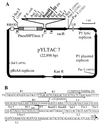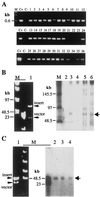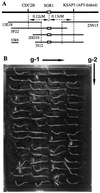Complementation of plant mutants with large genomic DNA fragments by a transformation-competent artificial chromosome vector accelerates positional cloning
- PMID: 10339623
- PMCID: PMC26917
- DOI: 10.1073/pnas.96.11.6535
Complementation of plant mutants with large genomic DNA fragments by a transformation-competent artificial chromosome vector accelerates positional cloning
Abstract
To accelerate gene isolation from plants by positional cloning, vector systems suitable for both chromosome walking and genetic complementation are highly desirable. Therefore, we developed a transformation-competent artificial chromosome (TAC) vector, pYLTAC7, that can accept and maintain large genomic DNA fragments stably in both Escherichia coli and Agrobacterium tumefaciens. Furthermore, it has the cis sequences required for Agrobacterium-mediated gene transfer into plants. We cloned large genomic DNA fragments of Arabidopsis thaliana into the vector and showed that most of the DNA fragments were maintained stably. Several TAC clones carrying 40- to 80-kb genomic DNA fragments were transferred back into Arabidopsis with high efficiency and shown to be inherited faithfully among the progeny. Furthermore, we demonstrated the practical utility of this vector system for positional cloning in Arabidopsis. A TAC contig was constructed in the region of the SGR1 locus, and individual clones with ca. 80-kb inserts were tested for their ability to complement the gravitropic defects of a homozygous mutant line. Successful complementation enabled the physical location of SGR1 to be delimited with high precision and confidence.
Figures




Similar articles
-
A novel Ti-plasmid-convertible lambda phage vector system suitable for gene isolation by genetic complementation of Arabidopsis thaliana mutants.Plant J. 1995 May;7(5):849-56. doi: 10.1046/j.1365-313x.1995.07050849.x. Plant J. 1995. PMID: 7773312
-
Development of an efficient maintenance and screening system for large-insert genomic DNA libraries of hexaploid wheat in a transformation-competent artificial chromosome (TAC) vector.Plant J. 2000 Sep;23(5):687-95. doi: 10.1046/j.1365-313x.2000.00827.x. Plant J. 2000. PMID: 10972894
-
The Arabidopsis TAC Position Viewer: a high-resolution map of transformation-competent artificial chromosome (TAC) clones aligned with the Arabidopsis thaliana Columbia-0 genome.Plant J. 2015 Sep;83(6):1114-22. doi: 10.1111/tpj.12949. Plant J. 2015. PMID: 26227242
-
Binary vectors and super-binary vectors.Methods Mol Biol. 2006;343:15-41. doi: 10.1385/1-59745-130-4:15. Methods Mol Biol. 2006. PMID: 16988331 Review.
-
Positional cloning in Arabidopsis. Why it feels good to have a genome initiative working for you.Plant Physiol. 2000 Jul;123(3):795-805. doi: 10.1104/pp.123.3.795. Plant Physiol. 2000. PMID: 10889228 Free PMC article. Review.
Cited by
-
Stable mitotic inheritance of rice minichromosomes in cell suspension cultures.Plant Cell Rep. 2015 Jun;34(6):929-41. doi: 10.1007/s00299-015-1755-3. Epub 2015 Feb 3. Plant Cell Rep. 2015. PMID: 25640468
-
A novel ankyrin-repeat membrane protein, IGN1, is required for persistence of nitrogen-fixing symbiosis in root nodules of Lotus japonicus.Plant Physiol. 2007 Mar;143(3):1293-305. doi: 10.1104/pp.106.095356. Epub 2007 Feb 2. Plant Physiol. 2007. PMID: 17277093 Free PMC article.
-
Cotyledon vascular pattern2-mediated inositol (1,4,5) triphosphate signal transduction is essential for closed venation patterns of Arabidopsis foliar organs.Plant Cell. 2004 May;16(5):1263-75. doi: 10.1105/tpc.021030. Epub 2004 Apr 20. Plant Cell. 2004. PMID: 15100402 Free PMC article.
-
SGR2, a phospholipase-like protein, and ZIG/SGR4, a SNARE, are involved in the shoot gravitropism of Arabidopsis.Plant Cell. 2002 Jan;14(1):33-46. doi: 10.1105/tpc.010215. Plant Cell. 2002. PMID: 11826297 Free PMC article.
-
Agrobacterium-mediated plant transformation: the biology behind the "gene-jockeying" tool.Microbiol Mol Biol Rev. 2003 Mar;67(1):16-37, table of contents. doi: 10.1128/MMBR.67.1.16-37.2003. Microbiol Mol Biol Rev. 2003. PMID: 12626681 Free PMC article. Review.
References
MeSH terms
Substances
Associated data
- Actions
LinkOut - more resources
Full Text Sources
Other Literature Sources
Molecular Biology Databases

